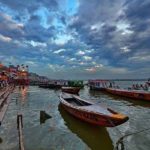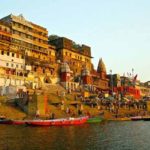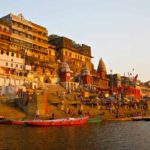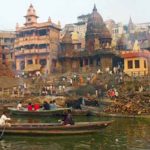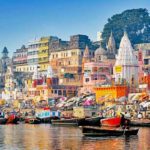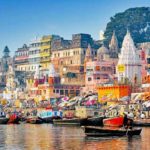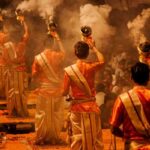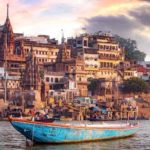Manikarnika Ghat Varanasi is one of the oldest ghats in Varanasi and has been accorded the highest position among other ghats by the holy scriptures in Hinduism. It is believed that if a person is cremated here, he immediately attains moksha (salvation). It is bound on both sides by the Scindia Ghat and Dashashwamedh Ghat. Like all the other ghats in Varanasi, the Manikarnika Ghat is surrounded by a fascinating mythological story which also tells us how it acquired its name.
It is believed that when Goddess Adi Shakti, or Goddess Sati, jumped into the fire and immolated herself, Lord Shiva carried her burning body to the Himalayas. There, he was immersed in unending sorrow. Lord Vishnu, moved by his plight, sent forth his Divine Chakra (one of his weapons) which cut Goddess Adi Shakti’s body into 51 pieces. Each of the place where her pieces fell on Earth were declared as a Shakti Peeth. Because her earrings fell at this ghat, it was established as a Shakti Peeth and named Manikarnika since Manikarna in Sanskrit means ear rings.
A variety of sights, sounds and smells greet you at the ghat. On one corner, you may see a priest sermonising to a crowd of people, while on the other, your eyes meet people engaged in rites related to cremation. As hundreds of bodies are consigned to the flames, the air is filled with smoke, perhaps reminding an onlooker of the inevitability of death and how temporary everything really is. Although photography is allowed at the Manikarnika Ghat Varanasi, one of the tourist attractions in Varanasi, care should be taken that there is no interference with the entire process.
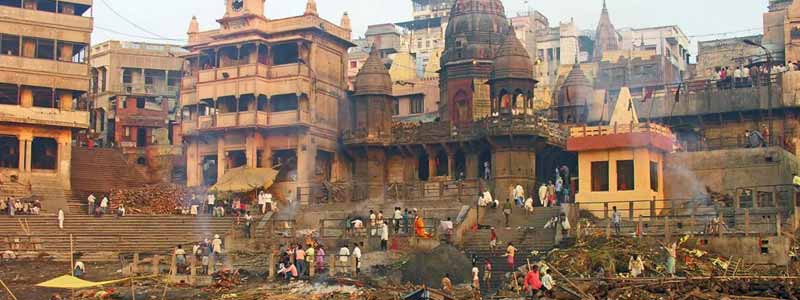
History of Manikarnika Ghat
It is said that the Manikarnika Kund, which epitomizes life, has been constructed by Lord Vishnu himself. He is said to be the preserver of life on this earth, while the Manikarnika Ghat, which embodies death, has been constructed by Lord Shiva who symbolizes death. He is said to reside in the ashes of the Manikarnika Ghat Varanasi. They reside side by side indicating life and death going hand in hand Varanasi Attractions.
Manikarnika Kund is said to be older that the River Ganges. At the behest of Lord Shiva, Vishnu touched the Kund with his discus and filled the same with his perspiration that was produced by the labor of creating this Universe. At this, Shiva quivered with delight and his earning feel into the Kund. Therefore, it came to be known as Manikarnika Kund.
There is another interesting legend behind the existence of the Manikarnika Ghat, which says that it existed from the time of the epic the Ramayana. It is said that Raja Harishchandra was the pyre man over here. For thousands of years, the light of the Manikarnika Ghat is said to be burning eternally, without dimming down Varanasi Tour Packages.
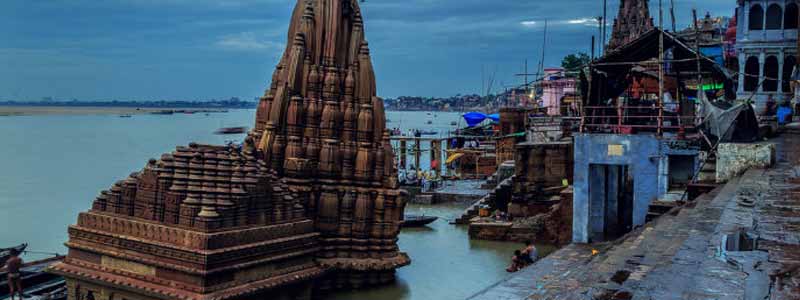
Significance of Manikarnika Ghat
Manikarnika Ghat Varanasi is also famous by the name of Mahasmasana which is one of two cremation Ghats in the Varanasi. Another famous ghat of cremation is Harishchandra Ghat. Manikarnika Ghat is historically associated with the Hindu God named Lord Vishnu and Lord Shiva. It is considered that the one who is cremated at this ghat will attain Moksha, the salvation and get directly intermingled into the Lord Shiva.
Manikarnika Ghat is also famous for the temple of the Lord Shiva and Mata Durga which was built around 1850 by the Maharaja of the Awadh. This temple has become the holy shrine of this Ghat. A holy pond named, Cakra-Pushkarini Kund (Manikarnika Kund) is also at this ghat which is believed that dug by the Lord Vishnu. According to the history, this kund existed earlier than the origin of the Ganges.
It is also considered that the Charanapaduka (the footprints) of the Lord Vishnu is here in a circular marble slab, as Lord Vishnu has mediated for many years at this ghat.
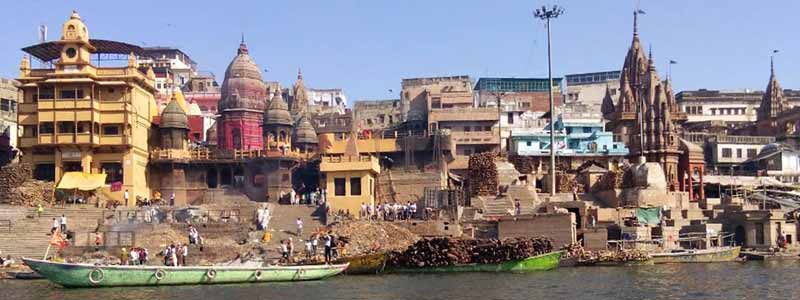
Best Time to Visit Manikarnika Ghat
Manikarnika Ghat Varanasi If you are looking for spotting cremations, the best time to visit is between 8 am and 7 pm. Every day, more than 300 bodies are cremated in this ghat. Thus, you can easily catch a cremation ceremony. However, finding boats early in the morning and by sunset is quite hard due to heavy demand.
In terms of climate, the winter is the right time to visit Manikarnika Ghat. The winter starts in October and ends in March. The worst time to visit is during peak monsoon, which starts in July and ends in August.
How to Reach Manikarnika Ghat
From airport, railway station, and bus stand, you can reach up to Godolia Chowk by hiring auto rickshaws, cabs or cycle rickshaws. From the Chowk, you ought to walk towards Manikarnika Ghat Varanasi. On the other hand, you can reach Dashashwamedh Ghat or Scindia Ghat and hire a boat to ride along the Manikarnika Ghat. No vehicles are allowed beyond the Godolia Chowk.

